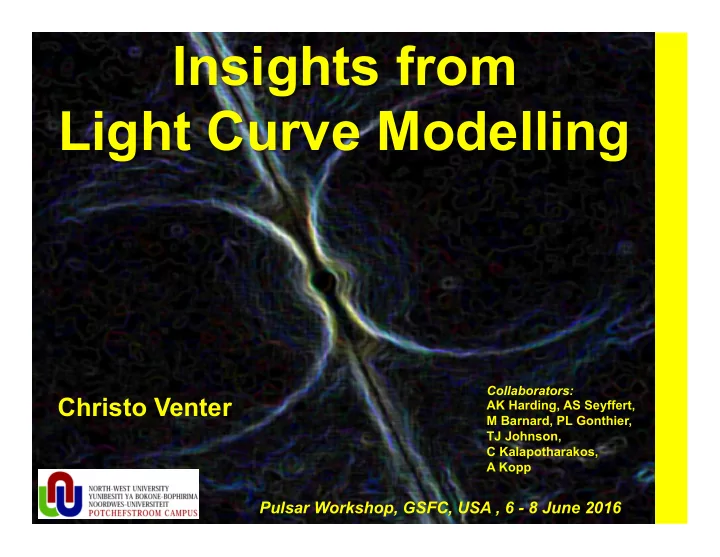

Insights from Light Curve Modelling Collaborators: Christo Venter AK Harding, AS Seyffert, M Barnard, PL Gonthier, TJ Johnson, C Kalapotharakos, A Kopp Pulsar Workshop, GSFC, USA , 6 - 8 June 2016
Thought houghts on on “The “T he Scient cientif ific ic Met ethod” hod” 1. How do I Test a Pulsar Model? 2. How do we Test a Pulsar Model? 3. How do we Constrain a Pulsar Model? 4. How do we Constrain Pulsar Models? 5. How do we Constrain Certain Aspects of Some Pulsar Models?
Testing / Constraining a Pulsar Model And using all available By making detailed data … predictions … “Messengers” “Observables” “System”
Testing / Constraining a ‘Pulsar’ Model Pulsed Isolated pulsars Light curves Photons Spectra Binary Pulsars Unpulsed Polarization PWNe Photons Particles Variability Binary Pulsars GWs Spin-down Globular Clusters Neutrinos? Morphology Pulsar Pop. MODEL “Messengers” “Observables” “System”
Tradi&onal Accelerator Geometries Ω Light α B Cylinder polar cap slot gap null charge surface outer Ω . B = 0 closed field gap region A. Harding
TPC Phaseplot as Function of α
Light Curve Calculation
Light Curves as Function of ζ
Radio Beam Geometry Single-altitude conal radio beam Harding et al. (2007); Gonthier (2004) cf. Arzoumanian, Chernoff & Cordes (2002); Kijak & Gil (2003); Mitra & Deshpande (1999) Total flux: B θ Cone radius: ρ core Cone position: θ cone Cone width: Emission altitude:
Atlas of Light Curves ( α , ζ ) Venter et al. (2009) Radio γ -ray
Major Conclusions • Three broad classes for HE / radio LCs • Copious pair production, even in MSPs • Gamma rays from outer magnetosphere, radio from lower down (except for phase- aligned LCs) • Important observables: Visibility, peak multiplicity, shape, off-peak emission, relative phase lag • Beaming is important (efficiency or L γ ) • Trends in 2PC provide further important tests Venter & • Major shift in thinking: OG vs. TPC / SG Harding (2014) to macro / microphysics questions
Some Open Questions 1. Rich variety of LCs: solely due to geometry, or distinct magnetospheric conditions and/or evolution effects? 2. No overall best-fit geometrical LC model: New / hybrid emission geometry? 3. Will preliminary trends strengthen? Do we need noncanonical pulsar parameters? 4. Preferred magnetospheric structure? Reconnection? 5. Origin of pulsed TeV photons? Venter & Harding (2014)
Refinements / New Directions 1. Multiwavelength constraints: pulsar geometry 2. Towards rigorous multiband LC fits 3. Effect of B -field and E -field on LC 4. “All roads lead to the current sheet”
Gamma-ray Quiet PSR J0855-4644 Chandra: Thermal X-rays: Low | β |? Double-torus fitting: ζ ~ |21 o | + 14 o Ng & Romani (2008) Maitra, Acero, & Venter, submitted
Radio Peak: Visibility, Multiplicity, Width Invisible 1P 2P 1P α < 40 o ; ζ ~ < 40 o 10 o < | β | < 25 o Invisible Maitra, Acero, & Venter, submitted
2. Rigorous Best-Fit Method Seyffert, Venter, & Harding , in prep.
3. Effect of B -field geometry / E -field → Static dipole B -field (Griffiths 1995) → Retarded vacuum dipole (RVD) (Deutsch 1955) → Offset-PC field characterized by parameters ε and φ 0 (magnetic azimuthal angle) (Harding & Muslimov 2011) Barnard, Venter, & Harding , submitted
Conclusions 1. Geometric LC models have taught us a lot about the emission region’s location and geometry 2. We need to keep refining and expanding them, since they may inform the physical models on geometrical aspects 3. We need to move to full emission models 4. “Ground” physical models in (e.g., LC / spectral) data
THANK YOU! “Love never fails…” (1 Cor. 13:8 NKJV). This work is based on the research supported wholly / in part by the National Research Foundation of South Africa (Unique Grant Number 92860, 2014)
Recommend
More recommend